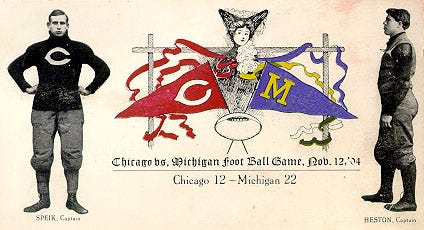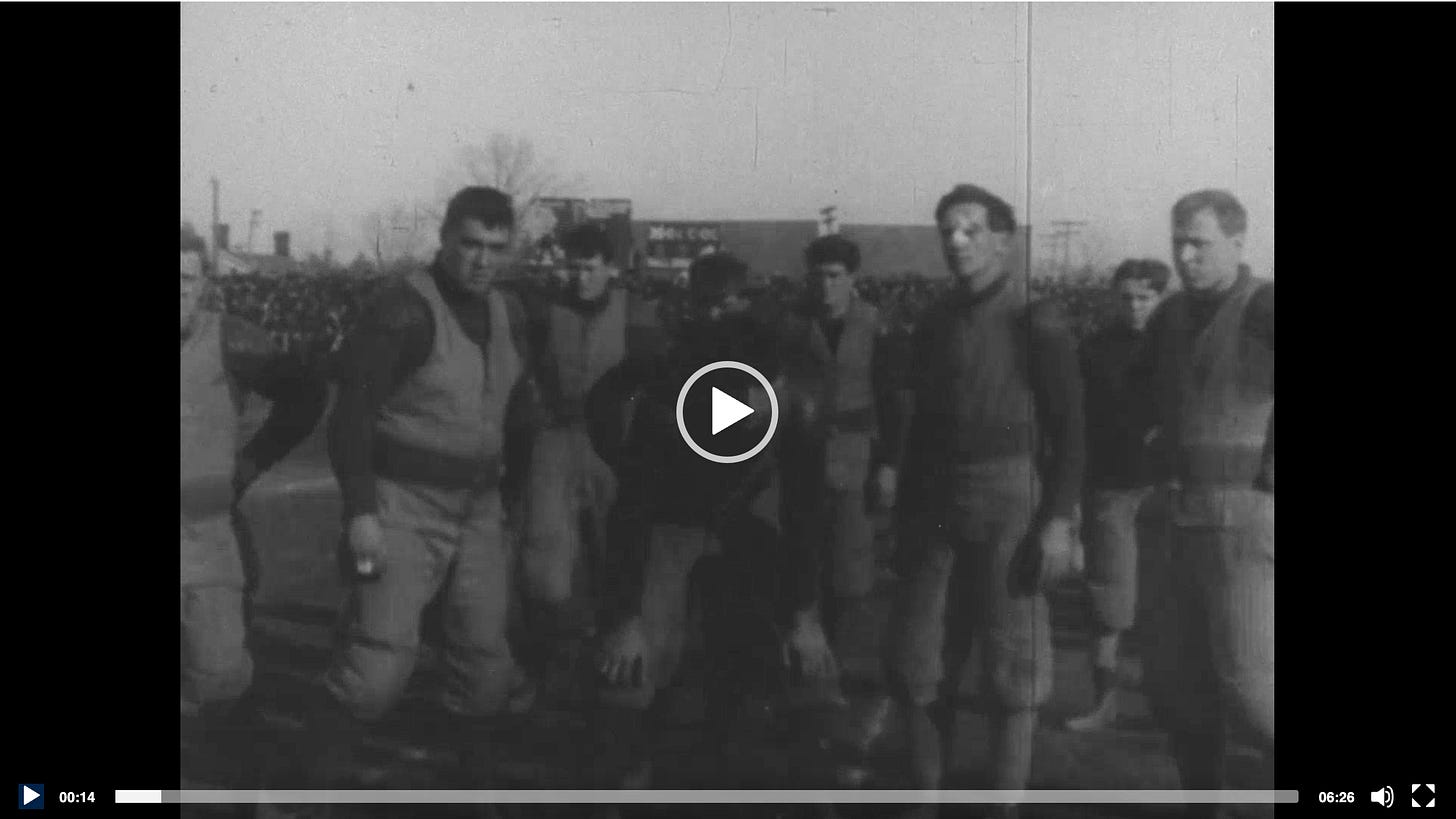Film Room: 1904 Chicago @ Michigan

In April 2023, I broke down the film of the 1903 Princeton @ Yale game and intended to do much the same with the 1904 Chicago @ Michigan game. However, the 1904 film shows bits and pieces of the game, making it difficult to tell who is who or when the action occurs in the game. Still, I'll tell the game's story based on newspaper reports and then point out moments of interest in the game film. (The Library of Congress labels the game as occurring in 1903, but a Detroit movie house hired Thomas Edison's American Kinetograph Company to film the game at Michigan's Ferry Field in 1904.)
Chicago, under A. A. Stagg, and the Fielding Yost-led Michigan Wolverines were the two best teams in the West in the early 1900s, with Michigan having the recent advantage. The Wolverines entered the season-ending game with Chicago with a 38-0-1 record over the last four seasons, having lost to Chicago in the final match of the 1900 season. During that streak, Michigan outscored its opponents 2,324 to 18. (Those are not typos.) They tied Minnesota in 1903 while running up some monstrous scores, including a 128-0 thrashing of Buffalo (1901), a 119-0 win over Michigan State, a 107-0 takedown of Iowa (1902), and they took West Virginia home via a country road 130-0 in 1904.

Chicago entered the game at 9-0-1, outscoring their 1904 opponents 380-11.

The highly anticipated game saw three trainloads of fans arrive from Detroit and a 15-car train ride East from the Windy City, boosting the crowd to an estimated 13,300.
The game went almost as Michigan fans expected. Despite Chicago leading 6-5 midway through the first half, Michigan scored twice more to take a 16-6 lead at the break.
For halftime entertainment, Michigan's subs released a pair of chickens, one with its feathers dyed blue and the other dyed maroon. The crowd howled as the blue chicken chased the maroon chicken around the field until the officials ordered the birds from the field, only to have the blue chicken evade capture far longer than the maroon bird.
On the second half's first play from scrimmage, Michigan laid an egg by fumbling. The ball popped into the air and into Chicago quarterback Walter Eckersall's arms, allowing him to race 35 yards untouched to close Michigan's lead to 16-12. That made the Maroons the first team to score twice against Michigan since Chicago did so in 1900.
The Wolverine fans feared that another miscue might lead to defeat, but Michigan scored a fourth touchdown and converted to claim a 22-12 lead they held to the final whistle.
Chicago beat Wisconsin the following weekend to finish 10-1-1, while Michigan went undefeated for the fourth straight year. Michigan went on a tear again in 1905, winning their first twelve games, outscoring their opponents 495-0 before falling to Chicago 2-0 in the final game of the 1905 season.
Now that you know the game's outcome, let's break down the film.
Note: The Library of Congress movie will not embed. Click the link to view the movie: https://www.loc.gov/item/mp73006300/
0:13 The film opens with Michigan's starters standing before the camera. (The guy who is second from left in the movie also stands second from left in Michigan's team picture. The same goes for the third player from left.)
0:27 We see two kickoffs in succession, though it is not clear who is doing the kicking. Football did not yet have tees, so a teammate held the ball for the kicker while two other teammates aligned in four-point stances on either side of the ball for no apparent reason. Also, note the checkerboard field markings.
0:44 The first play is a run up the middle, after which an injured player gets carried from the field. Chicago is likely the team on offense since they suffered more injuries and substituted at seven positions to Michigan's one. Plus, the injured player went to Chicago's sideline.

1:07 The film shows three consecutive plays near the goal line, with the third play likely showing Willie Heston's touchdown run over the left end that gave Michigan a 16-6 lead.
1:33 We see a series of plays, ending with another player being tended to for a head injury.
2:01 A play is run to the right but gets called back due to a penalty.
2:16 Shots of Chicago's bench (see the Wishbone C blankets) and the crowd
2:29 They run several plays one after another, highlighting football's rapid pace of play at the time.
2:50 Both teams are in tight formation, as they always were for non-punting plays, but note the player on the right who darts into the backfield just before the snap to become a backfield blocker. It is an example of the pre-snap movement on mass plays that remained part of the game in 1904.
3:00 The team with the ball aligns in punt formation with the ends aligned wide as gunners. Note the then-legal movement by the right end at the snap. The offense then runs several more plays up the gut with a rapid pace of play. The umpire enters the pile after each play to sort out the players.
4:06 The camera pans the stadium and crowd, presumably during halftime. The 5:15 mark shows the goal posts sitting directly on the goal line in the pre-end zone era.
5:34 Scenes of Michigan's bench
5:51 The runner fumbles on the play, and a teammate picks it up and continues downfield for a significant gain. The teams line up quickly and run another play, followed by a third. The film ends.
Hopefully, that is a fun look at the slug-it-out version of football that existed before the forward pass arrived on the scene.
Let me know if there are other early films you’d like to see broken down.
Football Archaeology is reader-supported. Click here to buy one of my books or otherwise support the site.




Coach Yost's nickname was "Hurry Up". When I read a listing of college football stats in an almanac he was listed as "Hurry Up Yost". That confused me until I found out his first name was Fielding.
It’s time to bring chickens back to halftime. Maybe for the next Super Bowl?